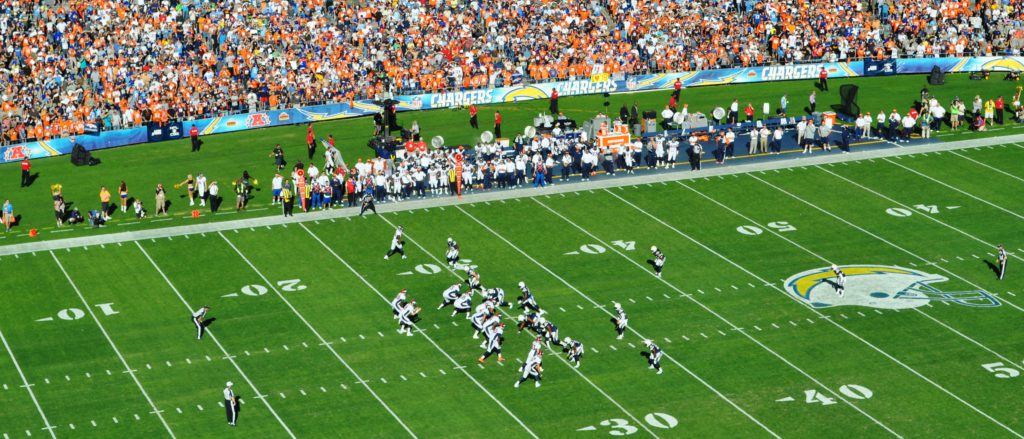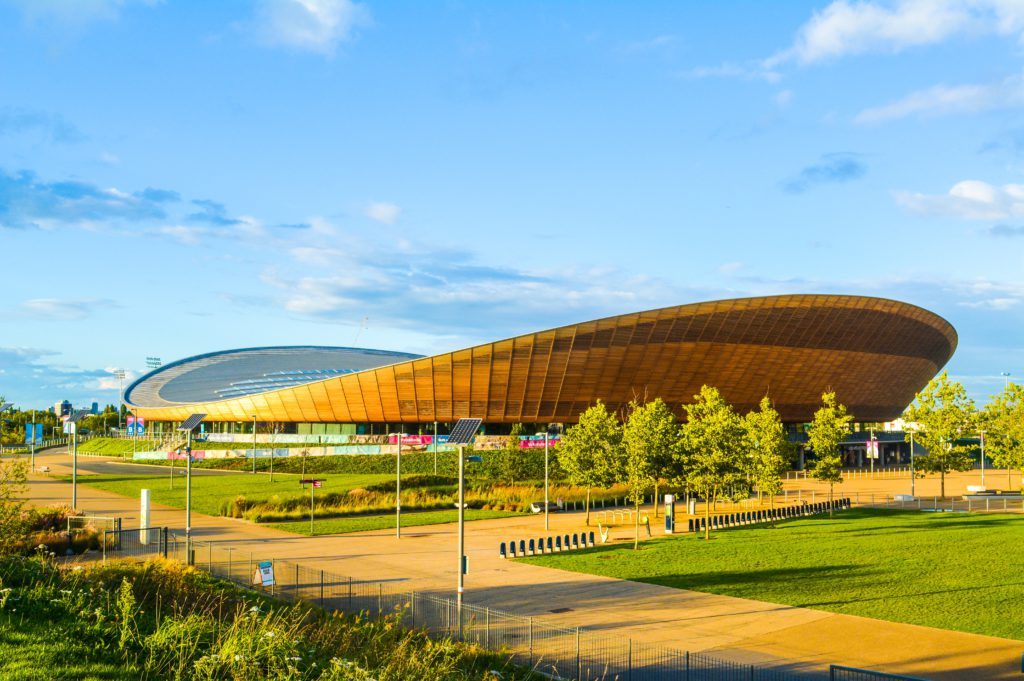Some industries get all the spotlight when it comes to sustainability, for better or for worse — think the fashion or food industry — while some fly quietly under the radar. No one really seems to talk much about professional sports and sustainability, at least not in casual conversation.
Considering that the North American sports industry alone was worth $71.06 billion in 2018, and the global sports industry was worth $488.5 billion, we think it’s definitely worth talking about.
While it’s pretty tough to get some hard numbers on the environmental impact of the professional sports industry, there are some official stats that give us a peek.
- Waste Management estimates that the NFL, MLB, NBA, NHL generate ~35,000 tonnes of CO2 each year from their fans.
- In 2010 the South Africa World Cup generated 2.75 million tonnes of carbon emissions.
- In 2014 the FIFA World Cup Brazil also generated close to 2.8 million tonnes of CO2 of carbon emissions.
- The 2016 Rio Olympics produced 4.5 million tonnes of CO2.
- Together, these three global sporting events generated the equivalent of burning 11 billion pounds of coal.
What’s behind the staggering carbon footprints of professional sports? Research has exposed a few main categories.

Travel & Accommodation
Each year, the top 200 stadiums in the US draw around 181 million visitors. 85% of greenhouse gas emissions created by major sports events come from the travel and accommodation of fans.
When FIFA was held in Russia in 2018, 5 million fans made their way over to spectate, and produced around 1.6 MM tonnes of CO2 doing it. That’s the same emissions of 500,000 home’s yearly electricity.
Food & Beverage
While we all may have different opinions on stadium food, those chilli cheese fries and hot dogs end up having a staggering effect on the environment.
Take the 2018 Russian World Cup for example: food and beverage ended up making up the second biggest greenhouse gas emissions for the event at a whopping 105,695 tonnes of CO2. During the Rio Olympics, around 14 million meals were served throughout the Games, which gave off 180,000 tonnes of carbon dioxide.
Infrastructure
When you host a major sports tournament, you build the facilities to match. That doesn’t just include the competition and training venues — we’re talking the offices, warehouses and meeting areas to support the event, athlete’s village, and the roads and bridges needed inside the zones. The intent behind these projects is usually to revitalize an area, but they do leave their environmental mark.
When the Rio Olympic Village was built for the 2016 Olympics, about 1.6 million tonnes of carbon dioxide emissions were generated. The prep alone for the infrastructure of the 2014 World Cup in Brazil generated 1.4 million tonnes of CO2.

Sustainability Wins In The Professional Sports Industry
While things may look grim for the sports industry, a surprising amount of changes have been happening behind the scenes.
The Emirates Stadium in England recycles 75% of their waste from game day, while Germany’s Allianz Arena has increased its energy efficiency by 60%, saving 362 tonnes of carbon dioxide per year. The Golden 1 Center in California creates 3,000 gallons of biodiesel per year by recycling the cooking oils used in their concession stands.
Some global sports events have even put sustainability at the top of their agenda. The Paris 2024 Olympics has an ambitious target: becoming “the Greenest Games Ever”. We’re in full support of that!
Let’s take a look at how the sports industry is shifting to earth-friendly practices in the above three categories.
Travel & Accommodation
You can’t stop sports fans from making the trek to cheer on their favourite team (with the exception of a global pandemic), but you can reduce their impact. Carbon offsetting has been identified by major sports leagues, like FIFA, UEFA and IOC, so they’ve been hard at work on low-carbon development projects globally.
Since FIFA started, they’ve been able to offset the 1.1 million tonnes of CO2 emissions that came from Brazil’s 2014 World Cup.
The European football league made a major sustainable move, announcing that it will offset all of the travel emissions from fans going to EURO 2020. Plus, they’ve partnered with all 12 host cities to give a public transportation pass to all fans that allows them to travel around the city with no extra charge on competition day, like FIFA did for the Russian World Cup.
The teams themselves have stepped up. For example, the French Federation of Table Tennis (yep, France’s ping pong team) has pledged that a minimum of 80% of their team travel will be using public transportation or car sharing.
Psst, wanna reduce your carbon footprint? Check out our Climate+ packages: we can help you go net-zero whether you fly internationally to support your team, take a weekend getaway for a game, or hit the road and make a trip out of it. Not traveling anytime soon for sports? We get it. You can also cancel the carbon footprint of your Netflix binging, the extra long showers you love, or your newfound food delivery habit.
Food & Beverage
There are options for professional sports organizations to work with sustainable and social businesses.
Take the Paris 2024 Olympic Games, for example. The Paris 2024 Organizing Committee and the Olympic Works Delivery Company (SOLIDEO) have joined forces with Canaux, the House of Social and Solidarity Economies, and the Yunus Center, to develop the ESS 2024 initiative.
ESS 2024 is a gateway between professional sports organizers, and the world of social entrepreneurship and circular economy. It’s purpose is to inform, mobilize and support sustainable businesses and entrepreneurs so they’re part of organizing and informing the planning of the Olympics.
Yoan Noguier, procurement manager for Rio 2016 Olympics and the founder of the Yunus Sports Hub, an organization that helps sports organizations solve social and environmental, makes an excellent point:
“A social business supplier may provide you the same product as a standard supplier, but will also address a local issue. For example, a catering company which only hires long-term unemployed people. This is the solution we’re proposing through ESS 2024 — maximizing the share of social business suppliers in the budget of sporting events, by informing them and helping them to be better choices than standard suppliers, also on operational and financial aspects.”
Because of ESS 2024, the Paris 2024 Olympic Committee has committed to using “100% sustainable and certified food sources for its competition”.
Infrastructure
Even though new infrastructure will continue to be built for World Cups and the Olympics, there are strict standards for construction and design that aim to reduce the event’s carbon footprint, and make events more sustainable.
For example, all of the stadiums in FIFA’s 2018 World Cup in Russia were awarded green certifications for both global and Russian sustainable building standards.
Qatar’s Khalifa International Stadium will use district cooling to regulate their stadium temperatures, a technology 40% more efficient than the average cooling system.
Paris 2024’s Olympic Village will be made up of low carbon and eco-designed buildings to reduce the environmental impact of construction.
Amsterdam’s Johan Cruijff Arena, host of one of the 2019 Champions League soccer semi-finals, is powered by more than 4200 solar panels, which generate around 930,000 kWh of electricity each year. That’s 10% of the stadium’s previous annual electricity consumption.
While the sports industry does have a huge impact on the planet, it’s encouraging to see sports organizations take ownership to make their practices earth-first. And this is just the beginning of a revolution in the industry.

Looking for an environmentally conscious team to root for (or at least admire — we get team loyalty)? We’ve got our eyes on:
Philadelphia Eagles
- Lincoln Financial Field houses 11,000 solar panels, and 14 industrial-size wind turbines, generating six times more electricity than the stadium needs for every Eagle’s home game combined.
- The franchise is actually offsetting fossil fuel power that would have been used by the surrounding city.
- Less than 1% of their trash ends up in landfills, and all cups and flatware used in the stadium are biodegradable.
Ohio Buckeyes
- This US college football team plays their home games at the ‘Zero Waste’ Ohio Stadium.
- 90% of trash is currently diverted from landfill through recycling and composting — bins are placed around the stadium.
- Their training center is powered by 237 solar panels, and the campus gets 21% of its electricity from wind.
- Ohio State aims to achieve complete carbon neutrality by 2050.
Sacramento Kings
- This NBA team plays at the Golden 1 Credit Union Center, the first full service LEED Platinum certified sports stadium in the entire world.
- The arena runs entirely on solar power, mostly generated from it’s own panels.
- The arena also reduces its power conception by letting the region’s naturally cool breezes flow through massive sets of doors.
Atlanta Falcons
- The New Atlanta Stadium uses solar panels to help to offset its energy consumption.
- The stadium will capture hundreds of thousands of gallons of water in a year to be used for internal cooling, irrigation of the field, and as an emergency water reserve in case of disaster.
Portland Trailblazers
- The Trail Blazers’ new arena was designed with energy efficiency in mind.
- Their “3’s for Trees” program pledges to plant three new trees for every 3-point basket the team makes each season. Last year, 3,300 new trees were planted in nearby areas as a result.
Seattle Kraken
- Amazon partnered with the Seattle Kraken to build the Climate Pledge Arena — it’s set to be the first-ever net-zero-carbon-certified arena in the world.
- For every hockey game or concert, arena operators will track the transportation of the fans, athletes and performers — by car, tour bus, train or plane — and then pay for carbon offsets to keep the venue 100 percent carbon neutral.
Check out our interview with Wilson Sporting Goods — one of the world’s top sporting equipment brands (think tennis balls for the US Open, and NFL footballs) — where we talk sports, sporting equipment and sustainability.

